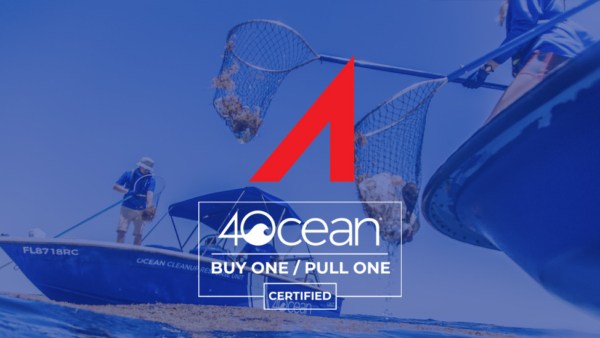Sunscreen is a sailing essential any time of year, but the upcoming summer rays mean it’s time to break out the good stuff. There’s nothing like relaxing on deck with some good music and lathering up with tropical scented potions to get that sun-kissed glow. But what happens once we shower off or go for a dip? Our goos and sprays quietly enter our waterways and air, about 14,000 tons per year according to the National Park Service. Many of these products can do serious harm to marine animals, as well as to our own health.
Coral Reefs Are In Trouble
Coral reefs are one of the most sought after sailing and tourist destinations in the world. Thanks in part to Hawaii’s gorgeous coral reefs, tourism accounts for about 20% of the state’s economy. In addition to damage from poorly placed anchors and clumsy snorkel fins, corals are struggling with a variety of environmental issues, including climate change, agricultural runoff, overfishing, disease, and storms. These stresses can cause corals to lose their symbiotic algae, called zooxanthellae, which provide the coral with their bright colors and nearly 90% of their energy. This “bleaching” process severely weakens the corals and is almost impossible to recover from.

When corals become bleached, they rarely survive.
Are We Making It Worse?
Believe it or not, most of our favorite sunblock brands contain chemicals that can severely increase corals’ chances of bleaching, disrupt their DNA and reproduction, and hinder their growth. These chemicals also disrupt the endocrine and reproductive systems of other marine animals. It’s worth mentioning that these ingredients, while they do protect our skin from the sun, aren’t healthy for humans either.
The worst offenders are oxybenzone and octinoxate, which are the UV-blocking chemicals in many sunscreen products. Oxybenzone can also be found in various body products, including lipstick, makeup, moisturizer, lip balm, nail polish, hair spray, and more. It only takes a very small amount of oxybenzone to harm corals: one study showed a toxicity effect can occur from a concentration of only 62 parts per trillion. That equates to a single drop of water in six-and-a-half Olympic-sized swimming pools. In many popular reef sites for tourists and swimmers, concentrations of oxybenzone can be 10 to 12 times the toxicity level.
To protect its reefs, Hawaii passed a ban in 2018 to prohibit the sale of products with these harmful chemicals, including some go-to brands like Coppertone, Banana Boat, Neutrogena, and Hawaiian Tropic. The law won’t officially go into effect until 2021 and it’s only for Hawaii, so it’s up to us as mindful sailors and ocean lovers to spread the word and start shopping smartly today.
How To Practice Safe Sun While Protecting Our Oceans:

- Read labels. Be on the lookout for oxybenzone, octinoxate, homosalate, octisalate, octocrylene, and avobenzone, to name a few. There are also dozens of other ingredients in our body and beauty products that are not ocean-friendly, like parabens, phthalates, fragrances, and microbeads. Here’s a list of harmful chemicals in many body products. And if you are overwhelmed by these lists (so am I!), keep reading.
- Try mineral sunscreen instead of chemical sunscreen. The active ingredient in mineral sunscreens is either non-nano zinc oxide or titanium oxide. These creams form more of a “physical barrier” from UV rays and are much safer for the ocean. They may take some getting used to, as these tend to be a bit thicker and can leave a white or bluish color on the skin. Some great mineral sunscreen brands include ThinkSport, Avasol, All Good, Raw Elements, Sea & Summit, Goddess Garden, Badger Balm, and more.My personal favorite brand for facial sunscreen is Avasol because it is tinted to match the skin and comes plastic-free!
- Buy a bigger bottle. Unfortunately, even ocean-friendly sunblock brands usually come in a plastic bottle. When you stock up on beach and boat supplies this year, go for bulk-sized bottles so you’re using less plastic.
- Avoid aerosol sprays at all costs. While convenient, aerosol sprays are extremely harmful to both our health and to the environment: they contain neurotoxic and carcinogenic chemicals, hydrocarbons, and volatile inorganic compounds (VOCs). The thin spray is more likely to get into the surrounding air and water than onto your skin, and because it’s so easy to apply, people often spray way more than they need.
- Plan for your swim. If you think you’re due for a dive off the stern, wait until after your swim to apply sunblock. In fact, if you are planning a day in or on the water, use as few sprays, lotions, and other chemicals on your body as possible. (You look absolutely beautiful without the hairspray and mascara, I promise!)
- Use other forms of protection. Sun protection is essential, but sunscreens are not the only way to protect yourself. Wear lightweight layers, hats, and sunglasses to supplement your sunblock, or set up a nice reading spot in the shade.
- Share your knowledge. No single person’s actions will save our oceans. It will take all of us coming together and sharing awareness to make meaningful change happen. Speak about these issues and guide your friends and communities toward solutions.
Please do your part by sharing this article with your favorite ocean lover:













